My previous two posts (Studying the Skeleton, Studying Musculature) are quite lengthy, and may contain an overwhelming amount of information for some of you. Try as I may to keep things simple, drawing the human body is a complex process, with lots of moving parts.
So, with that in mind, I’d like to take a step back with this post, and focus on the basics – concepts that can be understood by everyone, including those who aren’t interested in drawing. Today, we’ll be talking about stick figures.
An Introduction to Stick Figures
In some ways, you could consider the stick figure a sort of baseline for figure drawing. It’s a basic ‘skeleton’ (in terms of a visual framework) for drawing the human figure.
For this reason, stick figures are super common among starting artists and amateurs alike. This is evidenced by a phrase that I’d wager almost every single artist (across various skill levels) has heard at least once.

I’m pretty sure even my mom has said this to me.
Believe it or not, stick figures are actually quite useful, even as you become better at drawing people. You can achieve a decent amount of expressiveness with basic stick figures, through exaggerated posing.
Like I said, stick figures provide a basic visual framework for posing and drawing the human figure. Rather than thinking about all of the bones, ligaments, muscles, and tendons of a particular body part (like the arm, for example), you can instead represent that complex structure with a single line.
However, by virtue of their simplicity, most stick figures drawn by beginner/amateur artists look unrealistic, and (at times) lifeless.
So, how can we make these stick figures look more realistic, without a ton of extra work?
Remember, our goal here is to keep things simple, while also improving the appearance of our stick figures. If things get too complex, it defeats the purpose of drawing a stick figure: providing that basic visual framework I keep bringing up.
In order to fix these mistakes, we first have to know what they are, so let’s talk about some of the common mistakes people make when drawing stick figures.
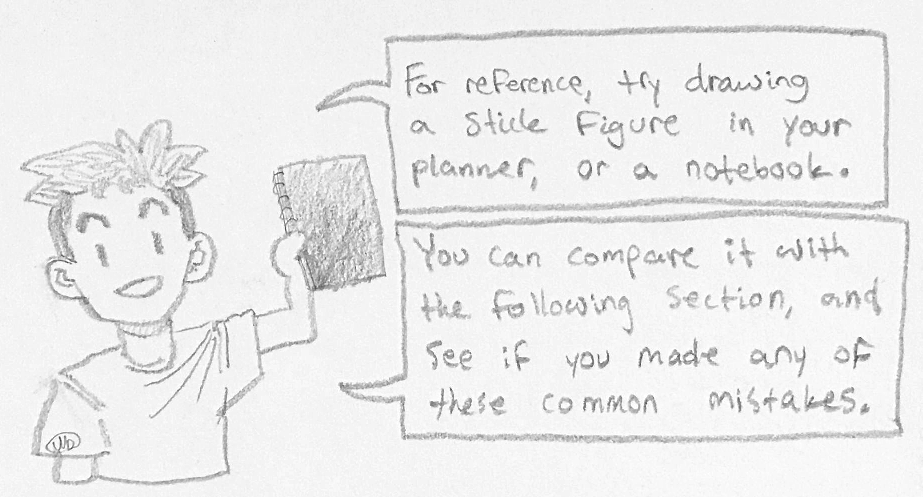
Common Mistakes
For starters, most stick figures have arms that start at the base of the neck. This is wrong. In some cases, these stick figures may lack a neck entirely.
Another common mistake is the torso being the longest part of the body. This is also incorrect.
Stick figures will also have legs which simply branch out directly from the body, at the base of the torso. The same could be said for the arms, which branch out from the body near the top of the torso.
In addition, these common stick figures will generally represent the arms and legs as singular lines. In reality, our arms can be divided into two sections (upper arm and forearm), and so can our legs (thigh and crus).
Along that train of thought, most stick figures will exclude hands and/or feet. This is, of course, inaccurate – hands and feet are extremely important parts of our anatomy.
For clarity, here’s the aforementioned mistakes written out in a simple list.

- Arms start at the base of the neck
- Neck may be missing entirely
- Torso is the longest part of the body
- Legs (and arms) branch out directly from the torso
- Arms and legs represented by one line
- Missing hands and feet
These mistakes are perfectly understandable, of course – they’re reasonable errors.
When drawing a stick figure, we tend to focus on the most ‘important’ parts of our body. In most cases, these would be the head, arms, and legs.
To that end, the middle portion of a stick figure (which vaguely represents the torso) is simply a place for the head, arms, and legs to originate from. Without that midline, those parts would just be floating in space, attached to nothing.
However, as evidenced by the fact that these are mistakes, they don’t accurately represent the human form.
Fixing those Mistakes
So, how can we fix these mistakes, without giving ourselves a ton of extra work? Well, as always, we should try to think logically.
Head and Neck
You need a neck, because neck muscles allow you to turn your head (among other things, of course). Without a neck, you would have to turn your entire body to look around, or search your environment for potential threats. Having neck muscles allows us to turn our head, without having to turn our body.

Arms and Hands
Along that train of thought, your arms don’t start at your neck. Your arms are attached to your body through a structure called the “shoulder girdle.” Let’s just draw a line for the clavicle (collarbone).

Now, to be clear, arms do not technically ‘start’ at your collarbone. As far as I’m aware, the humerus (upper arm bone) connects to your scapula, which then connects to your clavicle. Even though they’re closely related to one another, your scapula and clavicle are two separate structures.
Obviously, in this situation, that detail isn’t super important. For the sake of simplicity, we’ll draw a line for clavicle, and have our arms start there. Don’t forget to divide the arms into two separate lines – a circle or rectangle representing the hands will suffice.

Already, this is starting to look more realistic.
Torso
Now, we can draw a line for the torso. As mentioned in the previous section, your torso is not the longest part of your body. In reality, your torso is approximately 1/2 the entire length of your body (from head to toe). Please note that your torso should end above your hands.
In this case, the point of termination for our torso is a joint called the “pubic symphysis.” Anatomically, this joint is the half-way point of our body. Please note that the pubic symphysis is actually a part of your pelvis.

Hips and Legs
Much like your arms (which start towards the lateral edge(s) of your collarbone), your legs don’t just branch off from your torso – they start from your pelvis. The pelvis is one of the most complicated forms to draw, but since we’re focusing on simplicity, we’ll just be drawing a line to represent its width – as we did with the clavicle.
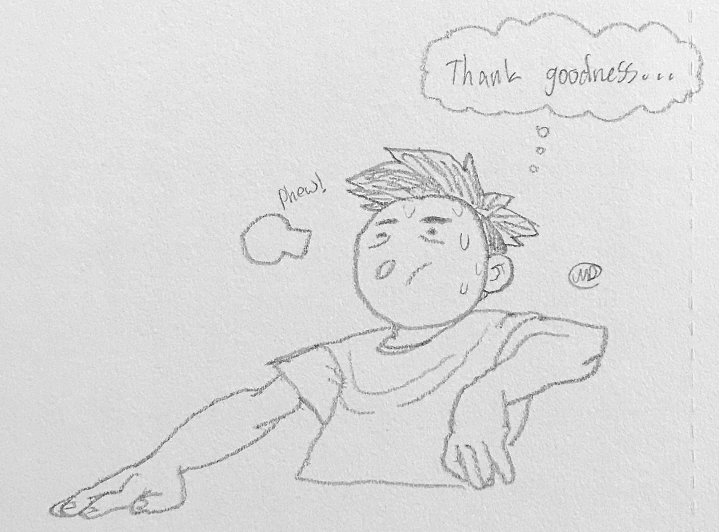
That saves us a lot of effort – drawing the pelvis is really hard.
The purpose of these two horizontal lines (representing the clavicle and pelvis) is to fix the ‘branch’ problem with common stick figures. In addition to providing a greater degree of realism to our stick figures, these lines make it easier to accurately render these body parts in perspective.
Now that we have a line representing our pelvis, we can attach the legs. Remember, we’re dividing the legs into two separate lines – just like we did with our arms.
Note that the tip of your middle finger (lowest point of the hand) should end about halfway down your thigh. Keep in mind that this is a general estimate. Arm length varies pretty heavily, so that measurement isn’t going to be accurate for everyone.
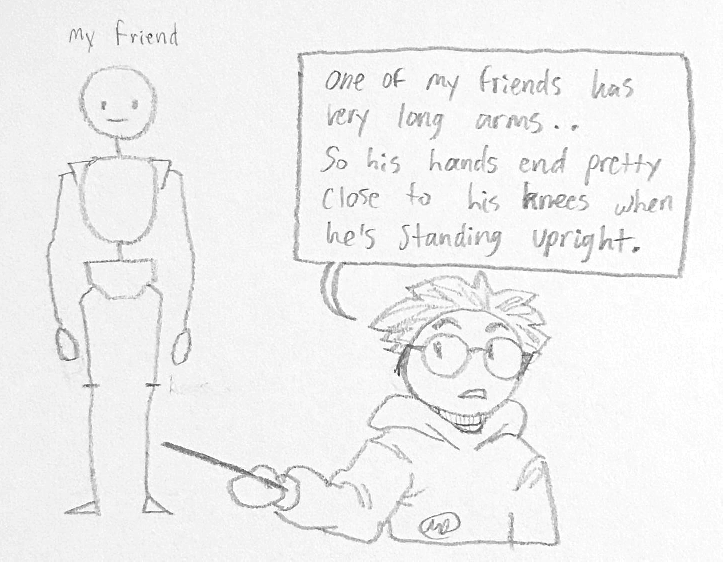
Since we’re focusing on simplicity, general estimates are just fine. Once you’ve drawn the lines representing your legs, you can add the feet. Personally, I think triangles are the most accurate representation of your foot’s shape, but you can use rectangles or circles if you want.

All done!
Our New and Improved Stick Figure
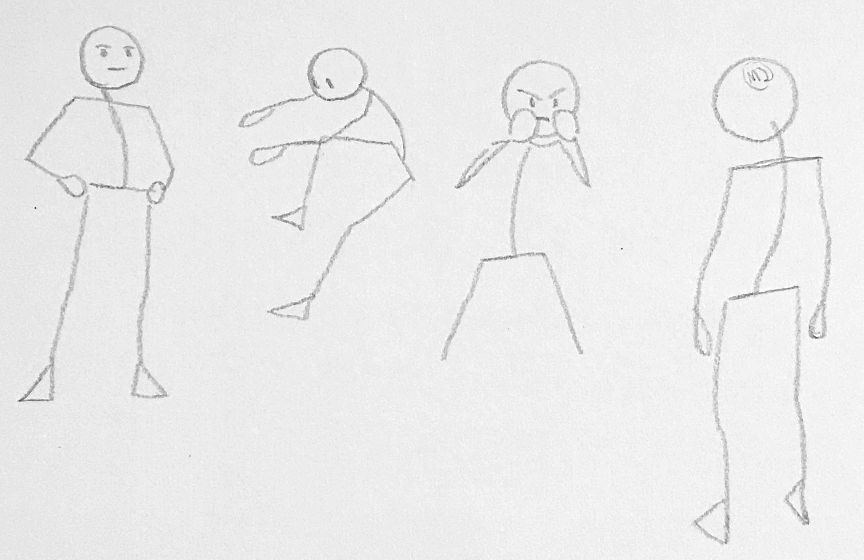
And hey, look at that! We’ve got ourselves a finished stick figure. This drawing already feels more realistic than our original stick figure, and more clearly represents that basic visual framework I brought up earlier in the post.
Even though this stick figure already looks pretty good, we can make them look even better through the use of shapes.
Adding Detail through Shapes
At the moment, our stick figure is.. well, pretty stick-like. That is, they’re lacking in mass. Even the skinniest people have what artists refer to as the “three major masses.”
These are important for figure drawing because they’re instantly recognizable, and help give a general idea of what sort of pose a person is in. Understanding the three major masses will make your figure drawings far more realistic.
Now, generally speaking, the three major masses are drawn as forms, which (as I’ve discussed in previous posts) are three-dimensional shapes. Since drawing 3D forms is a lot of work, we’re going to be simplifying them into 2D shapes.
Head (Skull)
Odds are, you’ve already drawn this one. Most stick figures will have at least one shape – a circle representing the head/skull. This circle is perfectly sufficient, so we won’t be adding any more detail to it.
In figure drawing, you’d usually draw a square or rectangle representing the mandible (lower jaw), but that’s not necessary for our stick figure.
Rib cage and Scapulae
We can use an oval to represent the ribs, with a triangle that represents the scapula on either side. Keep in mind that the scapula are located on the posterior (back) side of your body, so they should be slightly obscured by your rib cage.
We can then attach our arms to the scapula on either side, which makes things look a bit more realistic. Don’t forget to add the shapes representing the hands.
In this case, the top line of the ribs is basically just the line we used to represent the clavicle in the previous example. If you’d like, you can draw that clavicular line across the upper portion of the ribs, but that’s not entirely necessary.
Draw a line following your neck, representing your spine, at the bottom of the rib cage. This will connect with the pelvis shape, and helps create the illusion of overlap – which will give your drawing some depth.
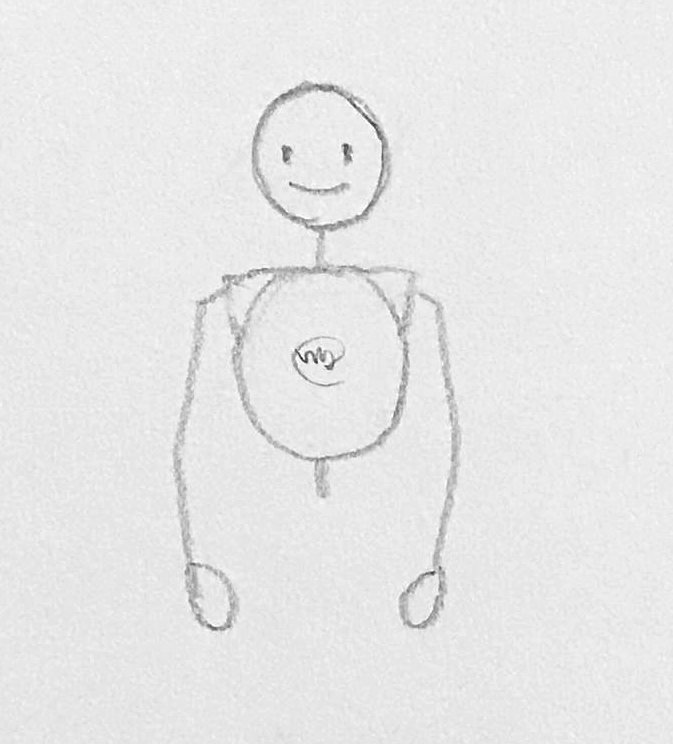
Pelvis and Legs
Lastly, we can draw another shape representing the pelvis. Really, it’s up to you which shape you decide to use for this mass. An oval, rectangle, or inverted (upside-down) triangle would look fine.
In my opinion, the most accurate shape for the pelvis is an inverted trapezoid, but again, you can draw whatever shape you’re most comfortable with. I like using a trapezoid, because we can attach the femurs to the sloped edges on either side of the shape.
Now, in addition to adding some detail to the pelvis, we’re going to add some detail to the legs. In our previous drawing, the legs of our stick figure were straight lines. In reality, our femur (upper leg bone) slopes inwards, slightly. Our femur also has a “neck,” which we’ll be representing by a shorter line connecting the femoral line, and pelvis. Don’t forget to add the shapes representing the feet.
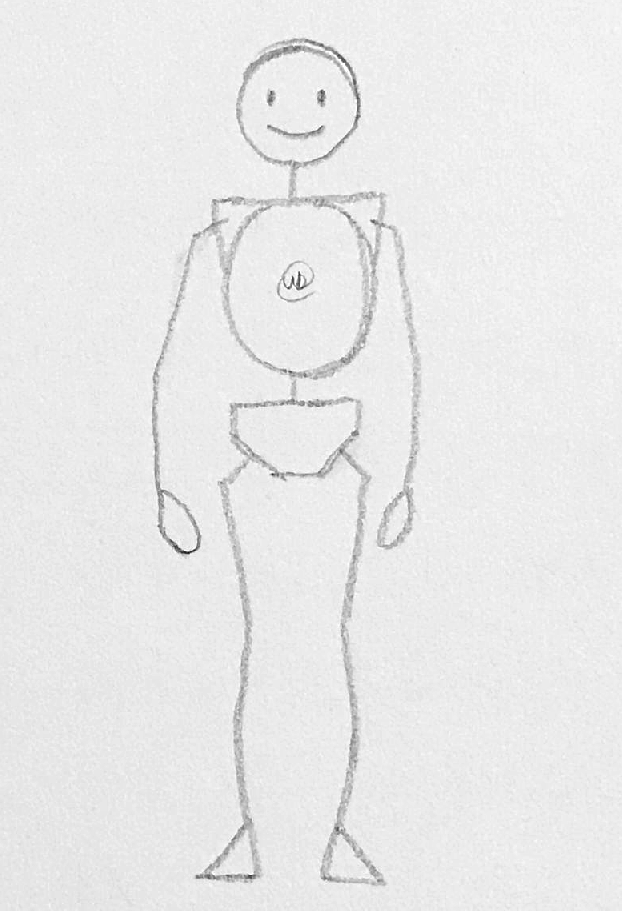
All done (again)!
Our New(er) and Improved(er) Stick Figure

With those final adjustments made to our figure, we’re done! (For real this time).
Even with these simple changes, our figure looks much more realistic. If you’ve been drawing along with me, you may find yourself surprised at just how easy it was to draw a more realistic stick figure. Drawing shapes and lines isn’t especially difficult, yet those simple shapes give life to your drawing(s).
Hopefully, you now feel more confident in your ability to draw stick figures. And as always, thanks for reading.
Disclaimer
All information in these posts is my own words, unless explicitly stated otherwise. None of this information is quoted, nor paraphrased, unless explicitly stated otherwise. Any similarities between my own words, and the informative sources/hyperlinks provided is purely coincidental, unless explicitly stated otherwise.
In any case where I am using someone else’s words (or imagery), the source will be cited internally, with a link to that source provided either within the internal citation, at the end of the post under “Sources,” or both.


March 14, 2021 at 4:34 am
I allows believed that the stick figure odd and does not represent a person. I agree that your new stick figure is realistic and practical.
March 14, 2021 at 9:25 pm
That’s good to hear! In truth, the more simplistic (original) stick figure serves a different purpose – being a completely simplified rendition of the human figure that can be drawn in seconds – and in that regard, it is actually more efficient.
My goal with this post was to create a stick figure that more clearly represented the human body and it’s basic anatomy, one that is more useful as an immediate reference for drawing the figure.
March 15, 2021 at 2:53 am
Stick figures are great to get a starting figure for a drawing. They might just be seen as something children draw, but they really can be the base of a drawing. I think this is a great topic to talk about and it was nice to get a refresher on things even though I have been drawing for quite some time. When I first began drawing I always had a hard time drawing the torso. I did one of the common mistakes you mentioned by making the torso way too long. Overall, this is a great post and it will definitely help people who are getting into drawing.
March 15, 2021 at 3:45 pm
They’re a relatively ubiquitous starting point for drawing people, so I think it’s a good spot to start when it comes to understanding the human form.
Admittedly, this would have been a good post to start with, rather than dumping loads of information and terminology about anatomy on people, but I didn’t even think of this blog topic until I was halfway done writing my post about musculature. At the very least, I’ll be able to go back and reference previous posts about anatomy, if/when I start discussing it more in-depth.
March 16, 2021 at 9:50 pm
I remember drawing stick figures all the time, especially during classes in grade school. However, none were quite as defined or complex as what you’ve shown here. I agree, though, that stick figures can make an excellent base for more complex and detailed art.
March 17, 2021 at 8:02 pm
I used to draw stick figures non-stop as a kid, I drew tons of little comic books with stick figure characters. Honestly, even through high school, you could consider many of my drawings from that time to be elaborations on stick figures, since they lacked proper form(s) and anatomy.
March 9, 2022 at 3:19 am
Wertuo
Wertuo
October 14, 2023 at 4:58 am
I like it
October 14, 2023 at 4:58 am
Hdudjr
December 27, 2023 at 2:28 pm
Reading idea’s always great for the students and the learners, but bad thing is student not being going to research with specific thing and keep doing sad emoji typically.
January 26, 2024 at 4:41 pm
My Brother is used to play like this
March 22, 2024 at 6:11 pm
Appreciation for really being thoughtful and also for deciding on certain marvelous guides most people really want to be aware of.
April 2, 2024 at 9:18 pm
Helpful.. so W
April 8, 2024 at 12:12 pm
Browser and it is very nice.
fraud
April 16, 2024 at 6:00 pm
Great content.I really appreciate your effort.Thanks
bolly4u
April 19, 2024 at 8:57 am
How you can make dinner even more delicious and special? Homemade rolls! These delicious Copycat Texas Roadhouse Rolls are perfectly fluffy and amazing with any dinner!
https://wordpress.com/tr/forums/topic/wordpress-okey-oyun-temasi-2/